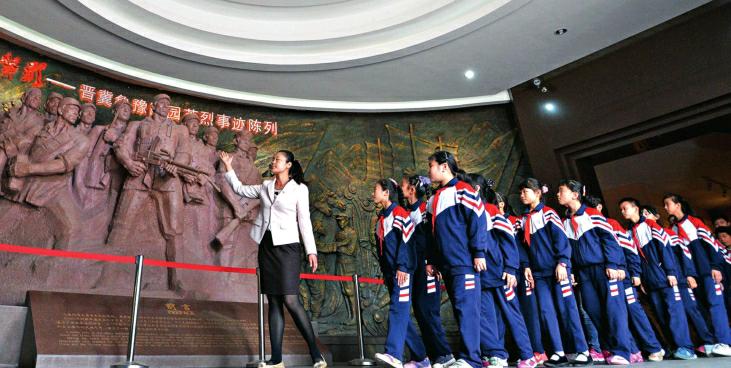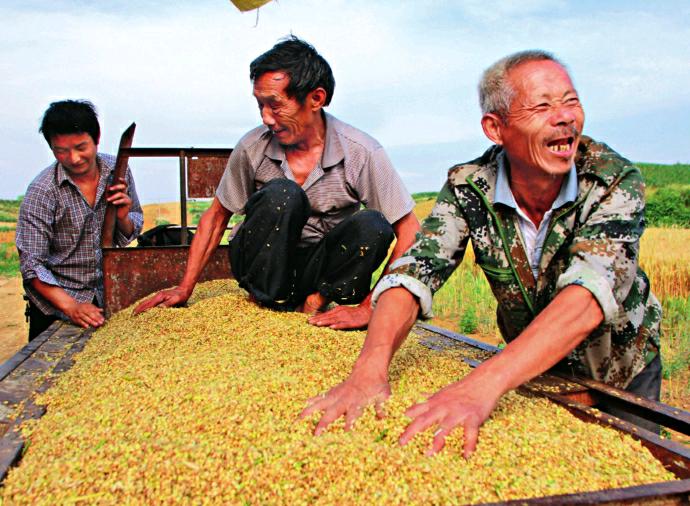A Big Country’s Great Aspirations
By+staff+reporter+TANG+SHUBIAO
IN 1956, Chairman Mao Zedong wrote in an article that China, as a country occupying an area of 9.6 million sq. km, and with a population of 600 million, should make a considerable contribution to humankind. However, for a relatively long period, Chinas contribution to world development was meager. The same year, Premier Zhou Enlai also remarked when receiving foreign guests that Chinas contribution had been minor: “Compared with our ancestors, we have a lot to do.”
What drove China, a big country with great aspirations, to this state? According to Deng Xiaoping, chief architect of Chinas reform and opening-up drive, in modern times, Chinas scant world involvement could be ascribed to century-long imperialist aggressions that surfaced following the First Opium War (1840-1842) and corruption in Chinas successive reactionary governments during the same period.
Discussions turned to how China could be lifted out of this awkward situation. During a meeting with the then president of Rwanda in 1978, Deng Xiaoping said,“We not only aim to develop our country and achieve the comprehensive modernization of agriculture, industry, national defense, and science and technology, but seek to contribute more to humankind.” By the end of that year, China had made a major policy adjustment, and shifted the countrys focus to economic development, thereby starting a new era of reform and opening-up.
The following 30-plus years witnessed a rapid rise of Chinas comprehensive national strength as the countrys yearly GDP grew at an average rate of nine percent. China not only improved its peoples livelihood, but made important contributions to maintaining world peace and promoting world economic and social development.
Maintaining Sustained Economic Growth
China has stuck to its path of reform and opening-up, and integrated with the world economy. In 2014, Chinas contribution to the world economic growth approached 30 percent. This year, China became the largest trade partner of more than 120 countries and regions with its outbound investment topping US $140 billion and imported commodities valued at US $2 trillion. China has introduced to the world abundant products of excellent quality at reasonable prices, and created a spate of jobs and investment opportunities for its global trade partners.
According to a U.S. study, over the last 15 years, Chinese investors have bought or created 1,583 U.S. companies that now employ more than 80,000 people full-time. Experts predict that in the next five years, Chinas imports will climb to US $17 trillion and its outbound investment will reach US $1.2 trillion, thus creating seven million new jobs around the world. Chinas ongoing economic transformation and upgrading, as well as its industrial restructuring, is set to last, bringing with it excellent opportunities for the world as regards international capital, technology, equipment, and services, to enter the Chinese market.endprint
China has taken its neighboring countries as cooperation partners to seek common development, and welcomes them aboard the train of Chinas development. China has thus maintained good economic and trade cooperation momentum with Japan, South Korea, Mongolia, Russia, and countries of Central Asia, South Asia, and the ASEAN. The China-advocated Asian Infrastructure Investment Bank, devoted to improving the infrastructure, financing, and investment environments in Asian countries, has been endorsed by many countries of the world. China proposed the Belt and Road Initiatives and set up the Silk Road Fund, seeking to connect its development strategy with those of its neighbors and countries along the Belt and Road, so as to promote regional interconnectivity and share with them the fruits of its development. Some observers believe that Chinas Belt and Road Initiatives will fuel the economic growth of all parties involved and contribute to realization of the worlds economic growth goal.
Accelerated Achievement of Millennium Development Goals
The UN Millennium Declaration made in 2000 specified eight millennium development goals (MDGs), with poverty eradication topping the list. The eight goals were intended to be met by 2015. Fifteen years of hard work have enabled China to reach the goals ahead of schedule.
China integrated the MDGs into its national development strategy. In 2013, China achieved the goal of poverty reduction, becaming the first country in the world to halve its proportion of population living in poverty. In addition, it made encouraging progress on the other seven MDGs of achieving universal primary education, promoting gender equality, reducing child mortality, improving maternal health, combating HIV/AIDS, malaria, and other diseases, ensuring environmental sustainability, and developing a global partnership for development.
In an interview with China Today, World Bank Country Director for China Klaus Rohland said, “China has outperformed any country in the world in terms of poverty reduction. From 1981 to 2012, China lifted 600 million people out of poverty. This is unprecedented, historically speaking.” Last April, in his speech at Peking University, former UN secretary-general Kofi Annan said that China had greatly contributed to the realization of the MDGs through its economic growth, poverty reduction, and by boosting other countries economic development.
China has upheld and participated proactively in international cooperation by advocating advancing development through trade and investment instead of blindly emphasizing development assistance. China has helped other developing countries build roads, bridges, hospitals, schools, and agricultural irrigation facilities, and exempted and reduced debts of heavily indebted poor countries, thus propelling South-South cooperation.endprint

China cooperates with Laos and Myanmar to implement the replacement cultivation plan, which has dramatically slashed local opium plantation areas, and increased local employment. In addition, China has also built infrastructural facilities in the two countries, which has promoted local economic and social development, and benefited nearly one million people.
Guarantee Food for the World
Despite occupying less than 10 percent of the worlds arable land, China contributes 25 percent of world grain output, and supports 1.3 billion people, 20 percent of the worlds population. In 2013, Chinas grain self-sufficiency rate surpassed 97 percent.
In efforts to achieve self-sufficiency in grain supply, China has played an active role in global food governance. In 2005, when grain assistance from other countries ended, China became the worlds third largest grain donor after the U.S. and the EU. It has since actively supported and participated in South-South cooperation guided by the UN Food and Agriculture Organization (FAO).
In Libya, Chinas experts demonstrated and promoted cultivation technology of hybrid rice varieties. After adopting Chinese hybrid rice seeds, local output increased by 300 percent. In Senegal, Chinese agricultural experts demonstrated how to cultivate the local rice variety in a high-yield way, which sent output soaring to 10 tons per hectare, setting a new record for the country in rice cultivation. In Uganda, Chinese experts demonstrated the cultivation technology of Chinese hybrid grain varieties, whose outputs could be up to 6.27 tons per hectare, three times local grain output. Ugandas agricultural officials highly praised China-assisted agricultural demonstration projects and said Chinese agricultural technology and innovations would help Africa achieve its economic transition.
As of the end of June, 2014, China had dispatched almost 1,000 agricultural experts to around 30 countries in Africa, Asia, and the South Pacific, 60 percent of the total dispatched under the FAO South-South cooperation projects. In multiple fields including irrigation and water conservancy, crop cultivation, animal husbandry and aquaculture, and agricultural product processing, Chinese experts have demonstrated and promoted more than 1,000 agricultural technologies in recipient countries, and trained local people by 100,000 persontimes, which has helped increase local output of crops including rice, corn, fruit, and vegetables by 30-60 percent on average. For that, the FAO presented China with a special contribution award for South-South cooperation.endprint
South China Sea Development to Benefit All
In May, China constructed two large multi-functional lighthouses on reefs belonging to the Nansha Islands in a move to fulfill international obligations. The South China Sea, both an important international maritime transport passageway and a major fishing ground, sees dense shipping transport flow. However, its complicated geographic conditions give rise to frequent maritime traffic accidents. The lighthouses on Huayang Reef and Chigua Reef are expected to provide efficient navigation to passing vessels and immensely improve navigation safety. Following this move, China plans to build other civil facilities on other reefs of the Nansha Islands to better serve countries along the coastline and passing vessels. Liu Feng, an expert on the South China Sea issue, indicated that Chinas move to provide navigation services in the South China Sea would help dispel and assuage any doubts or qualms the international community might harbor about Chinas motives in the region.
China has a history of construction of scientific research and civil facilities in the South China Sea. In 1988, it established the ocean hydrometeorology observation station in the Yongshu reefs. Commissioned by UNESCO, this manned observation station has the major task of observing hydrometeorological elements including wind direction, wind speed, thunderstorms, tide level, and waves. Over 27 years, the station has provided specialized data support to passing vessels in the South China Sea.
China has initiated several more research projects: In 2007, China commenced economic development activities like research on biodiversity and aquaculture in the Meiji Reef; in the Xisha Islands, China carried out navigation channel maintenance and constructed salvation facilities; and on the Yongxing Island, facilities for natural disaster prediction and prevention have been installed.
Proactive in Settling Issues
As a permanent member of the United Nations Security Council, China has proactively participated in solving hotspot international and regional issues, and fulfilled its duty of maintaining world stability and peace.
Earlier this year, Foreign Minister Wang Yi indicated that as a major country, China had conscientiously fulfilled its duty in maintaining world peace and security. As early as the 1950s, China participated in solving the Indochina issue; in the 1980s it mediated settlement of the Cambodia issue; and in the 1990s it initiated the six-party talks on the North Korea nuclear issue. Minister Wang held that China should continue to explore and develop effective approaches with Chinese characteristics in solving global hot issues. He added that more and more countries have come to count on and welcome Chinas involvement in settling global and regional issues. For example, Chinas proposition on advancing conflict resolution in South Sudan has been warmly welcomed by related parties.endprint
China has actively participated in international anti-terrorism drives, and joined hands with the international community in coping with global issues like climate change, cyberspace security, and issues concerning the polar region and outer space. China has also participated in UN peacekeeping operations, and has the largest number of peacekeeping servicemen among UN Security Council members. China has sent peacekeeping troops to Mali, and dispatched warships to the Gulf of Aden to crack down on piracy and ensure the safety of the related international navigation routes.
When the Ebola pandemic, the most serious public health crisis to appear in the world over the last 30 years, broke out, China immediately extended a helping hand. In addition, China has offered substantial support for Afghanistan in its triple transition of politics, security and economy, participated in negotiations on the Iran nuclear issue, and upheld denuclearization of the Korean Peninsula. In dealing with international hotspot issues, China upholds justice and puts world and regional peace and stability first. Such commitment is exemplified in the nations stances on Syria, Ukraine, and the Israel-Palestine conflict. China insists on peacefully solving disputes on territorial sovereignty and maritime rights with its neighbors through dialogue and negotiations, an approach endorsed and supported by most countries of the region.
Reshaping Global Governance
China encourages international and regional organizations like the UN, G20, Shanghai Cooperation Organization, Asia-Pacific Economic Cooperation, and BRICS to play bigger roles in global issues, so as to advance the process of world multipolarization, and enrich and improve the global governance system.
China participates in and maintains the international governance mechanism with the UN playing the leading role. To date, China has joined all UN specialized agencies and over 100 inter-governmental organizations, and signed more than 400 multilateral agreements. After assuming the rotating presidency of the UN Security Council in February, China proposed an open debate to the Security Council on maintenance of international peace and security, to reflect on history and reaffirm the commitment to and purposes and principles of the Charter of the United Nations. It thus commenced commemorations of the 70th anniversary of the founding of the organization. It is universally acknowledged that the proposal served as Chinas important contribution to maintaining the sanctity of the UN Charter as a golden rule and further consolidating the basic norm of international relations with the principle of the UN Charter as the basis.endprint
To cope with current global and regional economic and security challenges, China promotes transformation and reform of the global governance mechanism.
In the field of global economic governance, China supports the G20s major role in world economy. It put forward propositions concerning the IMF quota and governance reform and the World Banks voting power reform. Meanwhile China took the initiative to establish the Asian Infrastructure Investment Bank, Silk Road Fund and BRICS Development Bank, which have improved and complemented the current constellation of international financial institutions.
In the field of environment governance, China advocates intensified building of an international climate change mechanism and has set a quantitative emissions reduction goal.
Politically, China proposed building a new-type major country relationship, which offers the options of equality, mutual trust, inclusiveness, mutual learning, and win-win cooperation whereby world powers can participate in global governance. Moreover, Chinas Belt and Road Initiatives are bound to promote exchanges and cooperation among Asian and European countries.
China is now poised to further proactively and enterprisingly participate in international affairs, play its role as a responsible major country, and jointly cope with global challenges together with other countries. The world has great expectations of Chinas future moves.endprint

